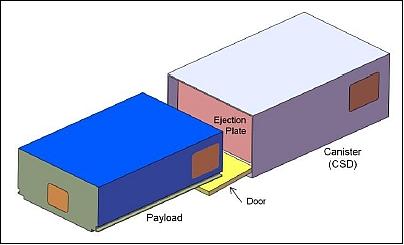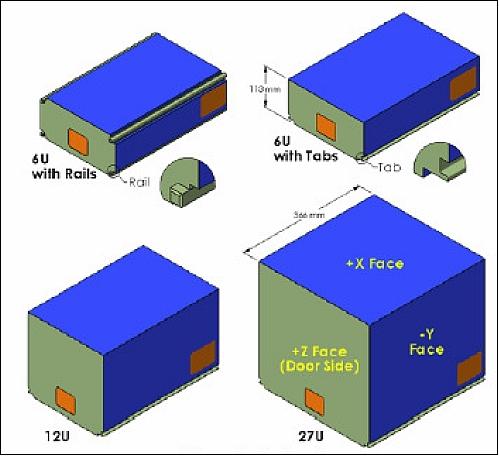CubeSat - Deployer Standards
Tools and Platforms
Related resources
CubeSat Concept - Deployer Standards for an Enlarged CubeSat Family
CubeSats have been extremely successful in easing access to space. The small size and encapsulation maximize launch opportunities and allow the payload designer liberties with materials and manufacturing techniques. It also enables the launch vehicle (LV) to utilize existing capability with minimal risk to the primary payload. 1)
Expanding upon the success of the 1U and 3U, a larger family of payloads will enable even greater scientific and military capabilities. These 6U, 12 and 27U payloads feature advanced technologies that streamline integration and ensure mission success.
The US government wants larger CubeSats than the existing P-POD (Poly-Picosatellite Orbital Deployer) can dispense. The new specification currently governs CubeSats larger than the 3U size. This includes deployer systems which are referred to as CSDs (Canisterized Satellite Dispensers) with the following physical parameter:
• 6U (mass of 12 kg, size of 12 cm x 24 cm x 36 cm)
• 12U (mass of 24 kg, size of 23 cm x 24 cm x 36 cm)
• 27U (mass of 54 kg, size of 34 cm x 35 cm x 36 cm).
These specifications were arrived at after extensive consultations with the main players of the existing CubeSat standards (Jordi Puig-Suari, Bob Twiggs, PSC (Planetary Systems Corporation) of Silver Spring, MD, and the US CubeSat community, including the military organizations of STP and AFLR). All members of the advanced deployer standard are referred to as the “CubeSat Standards Team”. The CSDs are boxes that small payloads (CubeSats) are housed in during launch and dispensed from once in space. These dispensers reduce the risk that small secondary or tertiary payloads in the dispenser can damage the primary or be damaged by the primary.
Standardization of the electrical and mechanical interfaces allows satellite builders and launch service providers to minimize the cost of integration to a launch vehicle because it greatly reduces the cost and time associated with nonrecurring engineering. Further, standardization allows the greatest number of competitors to offer competing products so the end user has many low cost choices.
Advanced Features
The 6U, 12U and 27U payloads and canisters incorporate several features aimed at increasing performance, reducing complexity and minimizing integration costs.
1) Tabs: Two tabs run the length of the payload and are intended to be gripped by the canister, functioning similar to an automobile's brake caliper and rotor. This eliminates excessive payload chatter during launch. It also provides a predictable and thus model-able dynamic environment. This is significant for the launch vehicle, especially as payloads increase in mass. It is also reassuring for critical payloads with sensitive instruments. The tabs also serve the benefit of reducing manufacturing complexity as only the tab thickness is tightly controlled. Furthermore, eliminating the rails at the other two corners provides more room for body-mounted or deployable solar panels.
2) Mass: The density of the 6U-27U payloads has increased slightly allowing more mission enabling technologies. The considerable mass can reduce thermal extremes on-orbit and increase orbit life.
3) Non-Constrained Deployables: The payload has the option to use the canister as the means of constraining deployables. This reduces the complexity and volume of the restraint/release mechanism. It also eliminates a potential failure mode.
4) LV Electrical Interface: A DB-9 socket connector is the standardized canister interface to the LV. The pin-outs and electrical parameters are predefined, allowing the LV to plan ahead and eliminate variances that inevitability increase cost. The connector is located on a consistent face to enable the LV to size and locate their harness. This inexpensive and compact connector has significant flight heritage on several separation systems.
5) LV Mechanical Interface: The standard mounting pattern is a repeatable square grid pattern, independent of canister size. Additional patterns may be added to allow compatibility with existing deployers.
6) Placard: The payload and canisters may be integrated several months or years ahead of launch. A placard informs the LV of the contents, provides traceability, and reaffirms conformance to a specification giving the LV and primary payload assurance of mission success.
Payload Specification for 6U, 12 U and 27U Configurations
A 6U CubeSat payload is shown deploying from its canister in Figure 1. The new sizes fill the existing mass and volume gap between 3U CubeSats and traditional separation system restrained secondary payloads such as ESPA [EELV (Evolved Expendable Launch Vehicle) Secondary Payload Adapter] and similar payloads.

These payloads are designed to be fully contained within CSDs (Canisterized Satellite Dispensers) during launch. A canister encapsulates the payload during launch and dispenses it on orbit. Canisters reduce risk to the primary payload and so maximize potential launch opportunity. Canisters also ease restrictions on payload materials and components. This specification currently encompasses three sizes of payloads. The 6U, 12U and 27U incorporate two tabs running the length of the ejection axis. The canister may grip these tabs, providing a secure, model-able, preloaded junction during launch. To maintain compatibility with existing standards the 6U can be made with typical rails as used in CubeSat. Note however with rails the payload is not preloaded in its canister and may chatter during launch. 2) 3) 4)

The interested reader is referred to references 2), 3) and 4) to get the detailed specification of the 6U, 12U and 27U configurations.
References
1) Ryan Hevner, Walter Holemans, Jordi Puig-Suari, Robert Twiggs, “An Advanced Standard for CubeSats,” Proceedings of the 25th Annual AIAA/USU Conference on Small Satellites, Logan, UT, USA, Aug. 8-11, 2011, paper: SSC11-II-3
2) http://www.planetarysystemscorp.com/
3) Ryan Hevner, Walter Holmans, Jordi Puig-Suari, Robert Twiggs, “Payload for Canisterized Satellite Dispenser (CSD) Specification Sheet,” PSC, 2002206 Rev A Payload Specification for 6U, 12U and 27U, June 13, 2011,, URL: http://media.wix.com/ugd/1c8e8f_1a22469e04cc02cebd01afe852c06bde.pdf?dn=2002206...
4) Ryan Hevner, Walter Holmans, Jordi Puig-Suari, Robert Twiggs, “Canisterized Satellite Dispenser (CSD) Specification Sheet,” PSC, 2002220 Rev - CSD Specification for 6U, 12U and 27U, June 13, 2011, URL: http://media.wix.com/ugd/1c8e8f_f5932fd80f81ebe83a33e5dd380e9269.pdf...
The information compiled and edited in this article was provided by Herbert J. Kramer from his documentation of: ”Observation of the Earth and Its Environment: Survey of Missions and Sensors” (Springer Verlag) as well as many other sources after the publication of the 4th edition in 2002. - Comments and corrections to this article are always welcome for further updates (eoportal@symbios.space).